The village of Moryntsi, the publication of "Kobzar" and the poet's exile are known from the school curriculum, but there were many other interesting facts in the artist's life that are less known to the general public.
Especially for the Kobzar's birthday, we have prepared a selection of 15 such facts - interesting and little-known information about Taras Hryhorovych.
Two years of school, two hundred years of glory
Taras's primary education was two years of study at a church-parish school. The future pride of Ukrainian culture - Shevchenko - owed much of his knowledge to Baroness Sophia Hryhorovna Engelhardt. The charming beauty taught the young Cossack Polish and French, and Taras received a general idea of the world from the lackeys.
Vibrant leisure

Taras Shevchenko with friends in St. Petersburg
Contemporaries of the genius claimed that Taras Grigorovich was fond of drinking since his St. Petersburg days. Most of all, he loved to visit the tavern near the stock exchange, where foreign sailors usually feasted between voyages. Quiet when sober, after drinking alcohol, Taras became uncontrollable: he swore at everyone, was ready to get into any fight. And getting drunk in company was a common thing.
One of the poet's acquaintances, who took an active part in the liberation of Taras from serfdom, told about the period of his life in Kazakhstan: "I go out at three o'clock in the morning to breathe fresh air. Suddenly I hear singing. And what do you think I see? Four people are carrying a door on their shoulders, removed from the hinge, on which two people are lying, covered with an overcoat, while others are walking on the sides and singing: "Holy God, Holy Strong!" - They are clearly burying someone. "What are you, gentlemen, doing?" - I ask them. "So, we had a party, they answer, - at which two of ours, Taras and the lieutenant, lay bones. That's how we carry them to their homes."
Dear "soul"

Pavlo Vasilyevich Engelhardt, landowner of Shevchenko
Different historical sources indicate different dates for Shevchenko's liberation from serfdom: some researchers call 1838, others say that Taras became a free citizen only a few years before his death. In his autobiography, Taras Grigorovich wrote that he owed his freedom to Karl Bryullov and Vasily Zhukovsky: the great Russian artist painted a portrait of the poet. It was decided to sell the painting at auction and spend the proceeds on Shevchenko's liberation.
The portrait was sold for a fantastic sum by the standards of that time – two and a half thousand rubles. The most interesting thing is that part of the money was provided by the imperial family, as recorded in her diary: for example, Empress Alexandra Feodorovna spent 400 rubles, the heir to the throne Alexander II and Grand Duchess Elena Pavlovna – 300 rubles each. Within a week, the landowner Colonel Mr. Engelhardt released this “serf soul”.
19th century hipster

Karl Bryullov, Self-portrait for the Uffizi Gallery, 1834.
We are accustomed to the image of Shevchenko, depicted in portraits as a tired, mustachioed man in a cap and retinue. However, such a one-sided picture does not quite correspond to the true image of Taras. Shevchenko was a young progressive democrat and did not like either excessive pomp or modest restraint in clothes. But during the years of his life in St. Petersburg, the fashionable portraitist earned decent money, which he happily spent on fashionable clothes. In particular, in his diary, the poet wrote about the special pleasure he received from purchasing a rubber mackintosh cloak, which cost 100 rubles. For comparison, while he was a member of the archaeological commission, Shevchenko earned 150 rubles a year.
"Urine Mordant Society"

Taras Shevchenko. Viktor Zakrevsky, his drunkenness. 1843.
Gultiy Shevchenko was friends with Viktor Zakrevsky, the Ukrainian founder of the humorous “society of the urinal.” The alcoholic society held regular meetings, at which the chairman was elected by “his drunkenness.” During a trip to Ukraine in 1843, Shevchenko also visited the “society of the urinal.”
The drinking companions drank noble secular drinks: rum, tinctures and liqueurs, having careless conversations "for life" and dreaming of freedom and a bright future. It was a kind of circle of drunkards - young freethinkers and people opposed to the Russian autocracy, which included Viktor and Mikhail Zakrevsky, brothers Yakov and Serhiy de Balmeny, historian M. Markevich, officer Tsikhonsky and others.
The young people, gathering, proclaimed free-thinking toasts, talked about: "the falsity of the noble and lordly life, which had developed over the centuries, and especially at the end of the 18th and beginning of the 19th centuries reached its highest degree...".
Lika Polusmakov: a wedding that didn't happen

Taras Shevchenko. Semi-sweet liqueur. Coal. 1860.
The 20-year-old hired girl Lykera Polusmakov completely captured the poet's heart, as is known from the artist's biography. At the age of 46, Shevchenko fell in love with the girl and was going to marry her. He prepared a dowry for the bride, prepared for the wedding, hired a city teacher for the rude and simple Lykera. But it was not destined to happen. Rumor has it that Taras found his beloved in the arms of the same teacher, which was the reason for the breakup.
According to the second version, Lykera herself did not want to go with Shevchenko to St. Petersburg, preferring to remain in her usual circumstances. But most researchers are inclined to the version that Kobzar understood that Lykera was greedy, rude and unscrupulous, and most importantly, agreed to marry Taras Grigorovich solely for selfish reasons.
Was there a boy?

Taras Shevchenko. Mykhailo and Maria Maksymovych, 1859.
Shevchenko had very friendly relations with the famous Ukrainian scientist Mykhailo Maksimovich Shevchenko. While visiting Moscow, Taras met the scientist's young wife, Maria. Warm friendly relations were established between them, they corresponded a lot, Maria promised to help in finding a bride for Taras. But some researchers of the Kobzar's biography are sure that the relationship between Maria and Taras was very close, because nine months after Taras visited the Maksimovich family, the couple had a son. And before that, they had no children.
However, opponents of this version argue that Taras would never have crossed the line, because Mykhailo was his close and loyal friend.
"Just not in Moscow, or I won't read it..."

Taras Shevchenko. Sketches on a letter to his brother Mykyta Shevchenko. 1840.
It is hard to imagine, but until the end of his life Taras Shevchenko wrote surprisingly illiterately. Here are fragments from one of his letters sent to his brother: "Brother Nikita, you need to bark at me, but I am not angry. Don't let it be like this, like a workman.... Kiss old grandfather Ivan for me, and bow to all our relatives, who are there... Tell Ivan's Fedorka not to let him write me a letter separately. - But only not in Moscow, otherwise I won't read it - Bow to him. Stay healthy - Your brother Taras Shevchenko."
"So that the meadows are wide, and the Dnieper and the cliffs are visible..."
The Kobzar has two graves: in St. Petersburg and Kaniv. After all, he was initially buried in the northern capital, at the Smolensk cemetery, where a memorial stone is now installed, and only two months later the coffin with the body of the deceased was transported to his homeland, to Kaniv, where he was reburied, according to the will.
Miniature "Kobzar"
Ukrainian master Mykola Syadrystyi has created the world's smallest "edition" of "Kobzar", measuring just over half a square millimeter – much smaller than a poppy seed. This is almost 19 times smaller than the smallest Japanese book. The pages are so thin and miniature that they can only be turned with the tip of a pointed hair. The binding is sewn with spider web, and the cover is made of an immortelle petal.
Shevchenko on Transnistrian banknotes
The memory of the Kobzar was somewhat unexpectedly honored in the territory of the unrecognized Transnistrian Moldavian Republic: in 1995, a 50,000-ruble banknote was put into circulation, on the front of which was a portrait of the Ukrainian hetman Bohdan Khmelnytsky, and on the back - a monument to Shevchenko in front of the university in Tiraspol.
And already in 2002, the design of the banknote was updated. Thus, a portrait of Taras Shevchenko appeared on the 50-ruble banknote. The banknote was greenish in color, so in the minds of Moldovans, it was not American dollars that remained "green" for a long time, but money with Shevchenko on it.
In 2007, the final design of the money was approved - a gray-green color with the unchanged Kobzar.
Shevchenko on Mercury
In 1973-1975, the Mariner 10 spacecraft took close-up photographs of Mercury for the first time. It was discovered that the planet's surface is covered with craters of various sizes. According to the rules of the International Astronomical Union, they were named after prominent artists, musicians, writers, and poets. Thus, one of the 300 craters on Mercury was named after Kobzar. The diameter of the Shevchenko crater is 137 kilometers.
Works of Shevchenko in Esperanto
Taras Shevchenko's works have been translated into more than a hundred languages of the world. Among them are Japanese, Korean, Arabic, and even the international language Esperanto. The largest number of translations was made into Russian, German, Polish, and English.
180 settlements

Shevchenko Peak in the Caucasus
In 1964, when the 150th anniversary of the Great Kobzar was celebrated, 196 settlements in the USSR were named after Shevchenko. Currently, 164 settlements in Ukraine are named after the artist. In Kazakhstan, Fort Shevchenko is named after him, and from 1964 to 1991, the city of Aktau was called Shevchenko. The same name also goes to 3 villages, 4 settlements and 8 hamlets in Adygea, Bashkortostan, Krasnodar Krai and 8 regions of the Russian Federation, and a village in the Rybnitsky district of Transnistria.
In addition, a bay in the Aral Sea and a 4,200 m peak on the northern slope of the Greater Caucasus, in the Side Ridge, are named in honor of Taras Shevchenko. This name was given to it by Ukrainian climbers who first conquered this Caucasian peak in 1939.
A record number of monuments

An unusual monument to Shevchenko by Ivan Kavaleridze
There are 1,384 monuments to Kobzar in the world. This is the second largest number for a single person. According to researchers, only the monuments to Jesus Christ are more. However, there is a version that Shevchenko is ahead of Vladimir Lenin. But in recent years, at least in Ukraine, the number of such monuments has significantly decreased.
There are 1,256 monuments in Ukraine, and another hundred and fifty in 35 other countries around the world, from Brazil to China.








Write a comment